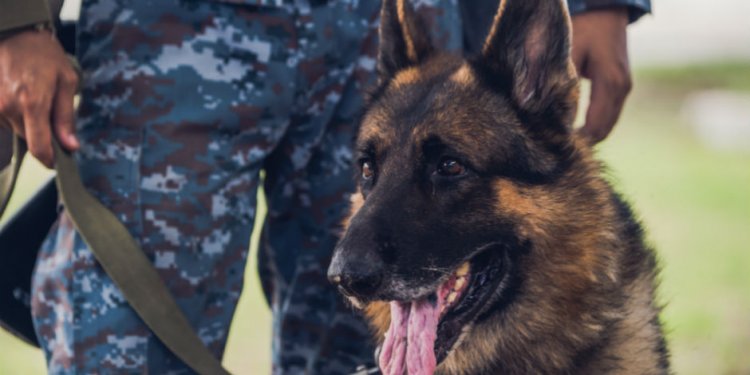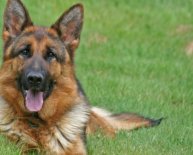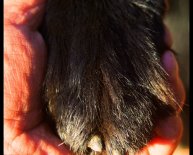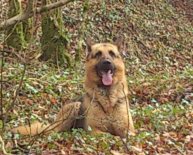
German Shepherd sub breeds
| Breed Popularity Ranking
#2 |
Breed Group
Herding Group |
Average Weight
50-88 lbs (approx.) |
| Country of Origin
Germany |
Personality Traits
Dauntless, intelligent, devoted |
Coat
Short - Medium |
The German Shepherd Dog is a large-sized breed belonging to the herding group of working dogs. Intelligent as it is versatile, this breed was originally developed in Germany to guard and herd a shepherd's flocks. The German Shepherd requires an active lifestyle, and makes for an ideal companion and protector.
Physical Characteristics
The German Shepherd has a double coat, which is comprised of a thick undercoat and a dense, slightly wavy or straight outer coat. Its hair, usually tan and black, or red and black in color, is medium in length and is shed all year round. Other rarer color variations include all-Black, all-White, liver and blue.
The German Shepherd's body is long - generally between 22 and 26 inches - in proportion to its height. This gives the dog strength, agility, elasticity and long, elegant strides.
Personality and Temperament
The German Shepherd is very protective and devoted to its family and home, maintaining a suspicious and aloof demeanor around strangers. It can be dominating and assertive towards dogs, though it is normally friendly with other pets in the home. The German Shepherd is an immensely versatile dog, displaying a keen intelligence while dutifully performing its tasks.
Care
The German Shepherd can live outdoors in cool or temperate climates, but enjoys living indoors too. Frequent training or exercise sessions are essential for keeping its mind and body active, and because the German Shepherd sheds throughout the year, its coat should be brushed once or twice a week to encourage turnover as well as to minimize buildup in the home.
Health
The German Shepherd has an average lifespan of between 10 to 12 years. It is, however, susceptible to some serious health conditions like elbow dysplasia and canine hip dysplasia (CHD), as well as minor problems like cardiomyopathy, hemangiosarcoma, panosteitis, von Willebrand's Disease (vWD), degenerative myelopathy, cauda equina, malignant neoplasms, pannus, hot spots, skin allergies, gastric torsion, cataract, and perianal fistulas. This breed is also prone to a fatal fungal infection due to the Aspergillus mold. Because of these susceptibilities German Shepherds, like most other dogs, need to be seen by a veterinarian for routine checkups. There they will undergo hip, elbow blood, eye and other tests.
History and Background
The German Shepherd breed over the years has served in many different capacities: police dog, guide dog, guard dog, war dog, explosives- and narcotics-detecting dog, search-and-rescue dog, show dog, and most notably as a shepherding dog. Developed primarily for the purpose of guarding and herding a shepherd's flocks, there have been few other breeds with such a versatile repertoire.
Max von Stephanitz, the first official breeder of German Shepherd Dogs, was attracted to the shepherding dogs used by Germans and, noting that there were many different types of shepherd dogs, concluded that a breed standard needed to be introduced. He was most fond of the shepherd dogs that had a wolfish appearance, with the strong upper body and prick ears, and that also had sharp minds and a willingness to work. In 1889 he bought a shepherd dog that met his ideal, changed the dog's name from Hektor Linkrshein to Horand von Grafrath (named for the nearby town of Grafrath), registered the dog under a new breed registry, and set about creating a standard, with Horand as the genetic basis for the breed. In that same year, the Verein für Deutsche Schäferhunde (roughly translated into the Society for the German Shepherd Dog) was formed by Stephanitz and Artur Meyer to advance the German Shepherd Dog's breed standard.
There is some debate as to how much wolf is actually a part of the German Shepherd breed. It was said that Horan was part wolf, and that Stephanitz used wolves in the crossbreeding. In Stephanitz's stud book there are four entires for wolf crosses at different points in the breed's development. However, some point out that at the time, many breeders use the term "wolf" to generically describe a pattern that is currently referred to as "sable." Other accounts suggest that if Stephanitz did use pure wolf genes, he was able to acquire the genetic input from wolves that were housed in a zoo. In any case, in 1923 when Stephanitz wrote his book, The German Shepherd in Word and Picture, he strongly advised against using wolves for crossbreeding.
Stephanitz focused on strength, intelligence and an ability to work well with people throughout, and succeeded so well that the German Shepherd Dog grew steadily in popularity. During World War I, the breed was selected as a war sentry by various countries. At the same time, the American Kennel Club (AKC) chose to alter the name of the breed from German Sheepdog to Shepherd Dog, while Britain renamed it the Alsatian Wolfdog - both in an attempt to separate the breed from its German roots.










